We may not have the course you’re looking for. If you enquire or give us a call on 01344203999 and speak to our training experts, we may still be able to help with your training requirements.
We ensure quality, budget-alignment, and timely delivery by our expert instructors.
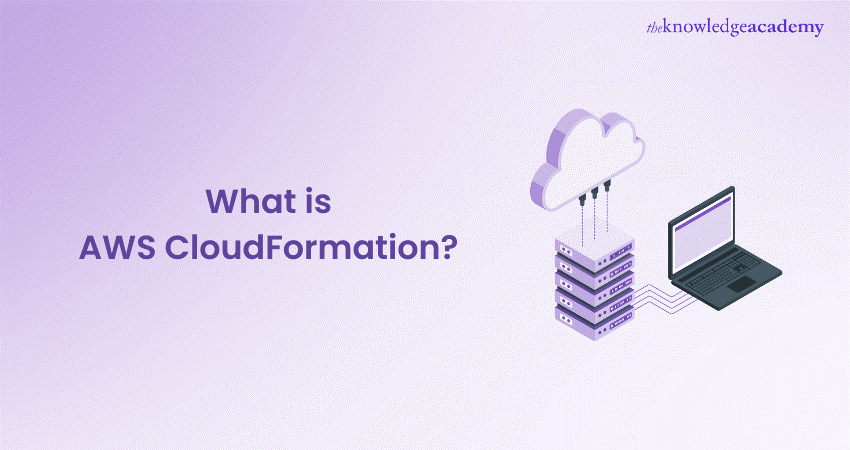
Are you struggling to manage cloud infrastructure without risking costly errors? You probably haven’t encountered the term “AWS CloudFormation.” AWS CloudFormation has completely changed the landscape of Cloud Computing. This is attributed to the significance of businesses that are aiming for scalability, reliability, and cost-effectiveness in their operational approach. Based on the study, AWS CloudFormation has significantly reduced the stack deployment time to 40%.
In this blog, you will study the complexities of AWS CloudFormation, including What is AWS CloudFormation, its key features, applications, benefits, limitations, related terminology, and associated topics. Let’s dive into it!
Table of Contents
1) Understand What is AWS CloudFormation?
2) Features of AWS CloudFormation
3) Applications of AWS CloudFormation
4) Advantages of CloudFormation
5) AWS CloudFormation - Attributes of Template Resources
6) Managing Access Control with CloudFormation
7) Terminology and Concepts in CloudFormation Templates
8) Conclusion
Understand What is AWS CloudFormation?
AWS CloudFormation is a service offered by Amazon Web Services that allows users to set up, define, and manage their cloud resources automatically. It enables the creation, management, and updating of a collection of related AWS resources, known as a stack, using templates written in YAML or JSON format. Using the CloudFormation applications, users can automate the deployment process of infrastructure resources to ensure consistency and reduce the risks of manual errors.
Features of AWS CloudFormation
With AWS CloudFormation, automating resource provisioning becomes much simpler and more convenient. It allows you to manage and define infrastructure using code, enhancing consistency and reducing manual efforts. Here are the key features offered by AWS CloudFormation:
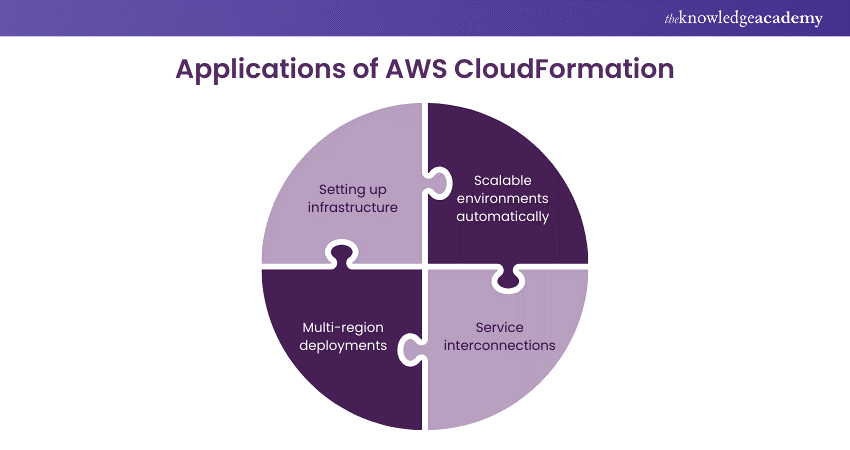
1) Infrastructure as Code (IaC): It helps define infrastructure resources as code, enabling version control, replication, and reuse.
2) Template-based: It also defines AWS resources and their configurations using simple, human-readable templates.
3) Automatic Resource Provisioning: AWS CloudFormation also automatically provides and configures resources according to the defined templates.
4) Dependency Management: It can easily handle dependencies between resources, to ensure proper sequencing during stack creation and updates.
5) Rollback on Failure: AWS CloudFormation can automatically rollback changes in case of failures during stack creation or updates, thus maintaining the desired state.
6) Drift Detection: AWS CloudFormation's efficient drift detection can identify any discrepancies between the deployed stack and the template definition. This reassures the audience about the system's ability to maintain compliance.
Prepare for success with top AWS Cloudformation Interview Questions. Start practicing today to ace your interview!
Applications of AWS CloudFormation
AWS CloudFormation is a powerful tool that automates the setup and management of cloud resources through an infrastructure as Code (IaC). Its applications extend across multiple use cases, allowing organisations to optimise resource management and scalability. Here are the applications of AWS CloudFormation.
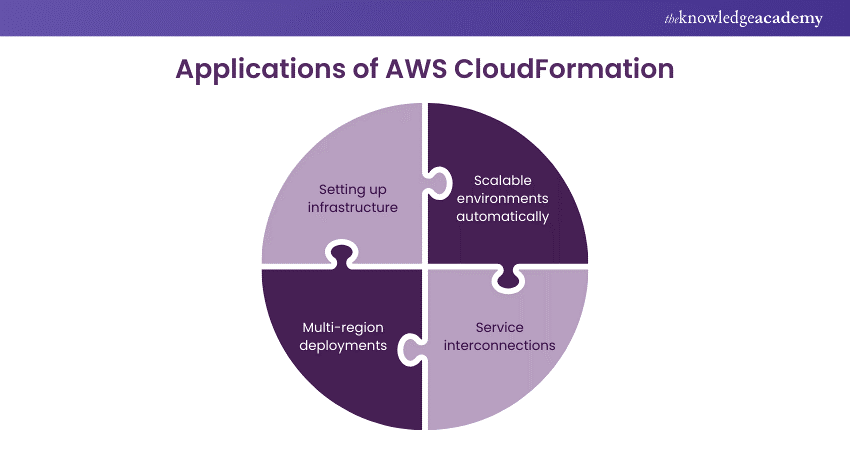
1) Setting up Infrastructure
AWS CloudFormation can easily streamline infrastructure setup by automating resource provisioning through code. Using declarative templates, users define the desired state of their infrastructure to promote reproducibility and consistency across environments. In addition, parameterisation enables customisation, while seamless integration with AWS services simplifies complex architecture deployment.
CloudFormation also handles dependency management and error handling to ensure proper resource sequencing and rollback on failures. This approach further accelerates the setup process, reduces manual errors, and allows for flexible, scalable infrastructure deployment.
2) Scalable Environments Automatically
AWS CloudFormation can create seamless, scalable environments. Integrated Through AWS Auto Scaling, it dynamically adjusts resources like EC2 instances and databases based on workload demands. In addition, flexible configurations enable users to set scaling policies and parameters tailored to their needs.
CloudFormation also seamlessly incorporates Elastic Load Balancers to distribute traffic and ensure high availability. Furthermore, it extends scalability to managed services like DynamoDB and Lambda. This feature optimises costs by provisioning resources efficiently. Using this application, organisations can easily automate the scaling process to ensure optimal performance and cost-effectiveness in their cloud deployments.
Kickstart your AWS skills with our Big Data On AWS Training- join today!
3) Service Interconnections
AWS CloudFormation simplifies the creation of interconnected environments, which are crucial for robust cloud architectures. Users can define networking infrastructure, including VPCs and subnets, to enable secure communication between services. Its cross-service integration seamlessly connects to EC2, RDS, and Lambda services. It also facilitates event-driven architectures and integrates services with event sources for dynamic trigger response.
Furthermore, CloudFormation supports service discovery through Route 53 and Cloud Map to ensure seamless communication between distributed services. By codifying security policies, IAM roles, and encryption settings, CloudFormation can readily enhance security and compliance across different interconnected services. Additionally, organisations can seamlessly build and manage interconnected architectures, fostering agility, scalability, and reliability in their cloud deployments.
4) Multi-region Deployments
AWS CloudFormation, a robust tool, is instrumental in ensuring data durability. It streamlines the orchestration of multi-region deployments, critical for enabling high availability and disaster recovery preparedness. Through its applications, users define templates that span across multiple AWS regions, enabling geographical redundancy and mitigating downtime risks.
Furthermore, its automation of cross-region replication of resources such as databases and storage provide a secure backup, ensuring data accessibility in case of regional failures.
CloudFormation facilitates disaster recovery strategies by automating failover procedures across regions, minimising downtime and ensuring business continuity. In addition, integration with services like Amazon Route 53 enables global load balancing, optimising application performance by directing traffic to the nearest available region.
By adhering to compliance requirements and data sovereignty concerns, CloudFormation ensures consistent enforcement of regulatory obligations across deployments. Overall, CloudFormation empowers organisations to architect resilient and scalable multi-region infrastructures efficiently, enhancing availability and compliance in the cloud.
Advantages of CloudFormation
AWS CloudFormation offers a plethora of AWS Benefits, ranging from revolutionising the way organisations manage to the deployment of their infrastructure. Let's delve into these benefits:
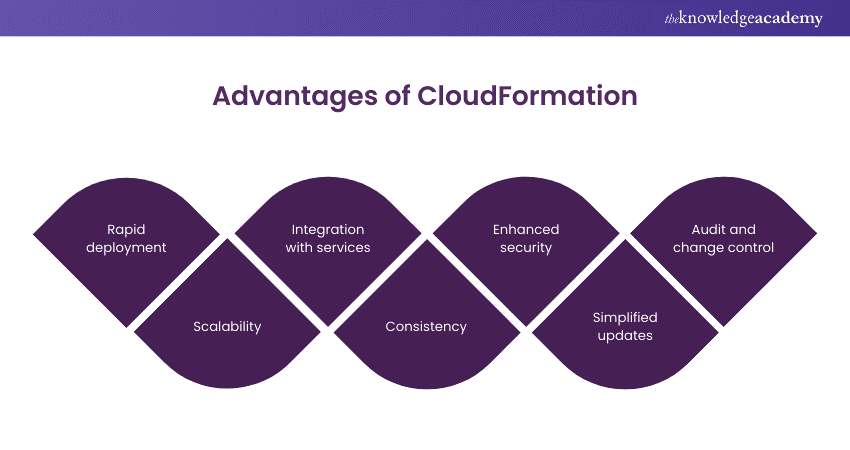
1) Rapid Deployment
AWS CloudFormation enables swift infrastructure provisioning through template-based automation. These Templates define resources and configurations, further automating deployment using a single command. This approach ensures consistency and repeatability across environments. Moreover, its rollback mechanism mitigates deployment errors and enhances reliability.
2) Scalability
AWS CloudFormation integrates seamlessly with AWS Auto Scaling to enable dynamic resource adjustments. AWS's flexible templates allow customising scaling parameters and efficient adaptation to workload changes. It also orchestrates Elastic Load Balancers for traffic distribution, optimising performance.
Additionally, integration with managed services like DynamoDB and Lambda can enhance scalability to a high level. While automated scalability minimises costs by adjusting resources to match demand, ensuring optimal resource utilisation.
Master AWS security through our Introduction to AWS Security Course – kickstart your career-boosting journey today!
3) Integration With Services
AWS CloudFormation can seamlessly integrate a broader range of AWS services, such as EC2, RDS, S3, and Lambda, into templates. Furthermore, by orchestrating service deployment, CloudFormation can ensure consistency and accuracy while reducing all kinds of manual errors. With its applications, users gain the ability to compose intricate architectures effortlessly, leveraging parameters for customisation.
4) Consistency
AWS CloudFormation also ensures uniformity in infrastructure deployments through template-based provisioning. These templates enforce standards to promote repeatability and standardisation across environments. Besides, version controls track changes, enabling accountability and collaboration. While automation eliminates manual errors, ensuring consistent and reliable deployments.
5) Enhanced Security
AWS CloudFormation strengthens security with IAM roles, encryption settings, and resource policies defined in templates. By seamlessly integrating with AWS security services like KMS and IAM, AWS can centralise security management easily. Moreover, templates enforce compliance with regulatory standards, codifying security best practices.
6) Simplified Updates
AWS CloudFormation facilitates seamless infrastructure updates. Here, users can modify templates to define changes and preview them with change sets before application. In addition, rolling updates ensure continuous availability, minimise downtime during the process, safeguard against failures and preserve stability.
7) Audit and Change Control AWS
CloudFormation ensures accountability and compliance through template versioning, change set reviews, and event logging applications. While change sets enable pre-deployment review, ensuring transparency and mitigating risks. Event logs also capture stack modifications for forensic analysis and compliance reporting.
AWS CloudFormation can integrate seamlessly with AWS Config to track changes to CloudFormation-managed resources. However, AWS Config must be enabled separately for this purpose and is not inherently part of CloudFormation. Additionally, when following the AWS Roadmap, role-based access control enforces granular permissions, restricting access to CloudFormation resources based on user roles.
AWS CloudFormation - Attributes of Template Resources
AWS CloudFormation provides several key attributes that enhance its ability to manage and automate cloud resources efficiently. These attributes help ensure that resources are created, updated, and deleted according to the specified parameters, improving infrastructure reliability and flexibility. The following are the key attributes of AWS CloudFormation:
1) CreationPolicy
In AWS CloudFormation, CreationPolicy ensures resources like EC2 instances or RDS databases are successfully created before stack creation proceeds.

It then uses the ‘WaitCondition’ resource to pause the creation of a stack until specified resources are ready; however, it is not employed by default in all cases. This attribute prevents premature resource usage, which is crucial for effectively handling dependencies. By setting conditions for resource creation, CloudFormation ensures the orderly provisioning of resources, reducing the risk of stack creation failures.
Accelerate Your ML Skills with our AWS Machine Learning Training- join today!
2) DeletionPolicy
In AWS CloudFormation, DeletionPolicy determines the conditions of sources when a stack is deleted.

By setting "Retain," critical resources, including S3 buckets or RDS databases, remain intact post-deletion, further preventing data loss. DeletionPolicy also safeguards against accidental resource deletion, providing a safety net for managing resources responsibly. This definition of DeletionPolicy is crucial to avoid unexpected data loss during stack cleanup.
3) Metadata
In AWS CloudFormation, Metadata provides additional information about resources in templates to enhance documentation and understanding.

Structured as key-value pairs, it offers details ranging from version numbers to descriptions. Metadata serves as template annotations that provides context and insights into resource purposes. By enriching resource descriptions, Metadata improves template visibility and comprehension for developers and administrators.
4) UpdatePolicy
In AWS CloudFormation, the UpdatePolicy attribute is crucial in managing resource updates during stack modifications.

It enables organisations to exercise precise control over the behaviour of resource updates to ensure minimal disruption and maintain application availability. With UpdatePolicy, users can implement rolling updates, defining parameters such as the number of resources to replace simultaneously and the pause time between replacements.
This approach ensures a gradual transition, minimising downtime and potential user impact. Additionally, UpdatePolicy integrates seamlessly with Auto Scaling groups, facilitating rolling updates by adjusting instance capacities and tolerating instance terminations. This customisation allows you to tailor update strategies according to your specific resource requirements, thereby optimising performance and reliability throughout the update process.
5) DependsOn
In AWS CloudFormation, the DependsOn attribute manages resource dependencies, ensuring proper sequencing during stack operations.
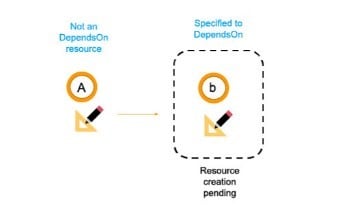
Users define dependencies between resources to ensure certain resources are created or updated before others. This not only prevents deployment errors but also promotes predictability, giving you confidence in the system's performance.
DependsOn orchestrates the order of resource provisioning or updates, supporting cross-resource relationships to model complex architectures effectively. It ensures that interdependent resources, like an EC2 instance relying on an attached EBS volume, are resolved before proceeding. By enhancing reliability and reducing the risk of creation failures, DependsOn facilitates smoother deployments and updates in AWS CloudFormation.
Managing Access Control with CloudFormation
Managing access control with AWS CloudFormation is essential for maintaining security and proper resource management across your infrastructure. By utilising the applications of AWS Identity and Access Management (IAM), CloudFormation enables fine-tuned control over who can access and manage specific resources. Below are some key features and strategies for effectively managing access control with CloudFormation:
1) IAM Roles and Policies: AWS CloudFormation utilises IAM roles and policies to manage access control.
2) Resource-level Permissions: It doesn’t enable permissions at the resource level.
3) Access Control Scope: Access control applies to actions on stacks and resources managed by CloudFormation.
4) Role-Based Access Control (RBAC): RBAC is enforced via IAM roles and policies, reducing unauthorized access risks.
5) Parameterised Settings: Access control settings are parameterised for dynamic assignment, offering flexibility in permissions.
6) Integration with AWS Organisations: This integration centralises management across accounts, ensuring consistency.
7) Continuous Monitoring: It facilitates auditing and timely detection of misconfigurations.
8) Security and Compliance: CloudFormation’s robust access control features empower organisations to enforce security best practices and maintain compliance efficiently.
Terminology and Concepts in CloudFormation Templates
Understanding the key terminology and concepts within AWS CloudFormation templates is crucial for efficiently managing infrastructure as code. Below are some essential terms and concepts that will help you navigate and create effective CloudFormation templates:
1) Template: A JSON or YAML file defines your infrastructure as code. The key templates include resources, parameters, mappings, outputs, and optional sections like metadata and conditions.
2) Resource: Resource is a term that represents an AWS component like EC2 instances, S3 buckets, or IAM roles. They are defined in the template and managed by CloudFormation.
3) Parameters: Parameters are the Input values for customising stack deployments. They allow users to specify settings such as instance types, storage sizes, or VPC IDs.
4) Mappings: Mapping are the key-value pairs for mapping input parameters to corresponding values based on predefined conditions. It is widely useful for defining regional settings or environment-specific configurations.
5) Outputs: Outputs are the values generated during stack creation or updates, such as resource IDs or endpoint URLs. Outputs allow users to retrieve information from the stack for external use.
6) Metadata: Metadata are the additional information about the existing data, such as version numbers or descriptions. Metadata enhances documentation and understanding of template resources.
7) Conditions: Conditions are the conditional statements that control resource creation based on specified conditions. They enable dynamic resource provisioning based on environment or input parameters.
8) Intrinsic functions: They are built-in functions for performing common operations within templates, such as condition evaluation, resource referencing, or string manipulation.
9) Stack: The collection of AWS resources defined in a CloudFormation template and managed as a single unit is called Stack. It can be created, updated, or deleted as a cohesive unit.
10) Change Sets: Change Sets are the previews of proposed changes to a stack before execution. Change sets allow users to review modifications and assess potential impacts before applying updates.
Conclusion
We hope you understood What is AWS CloudFormation. AWS CloudFormation is a vital source for creating, managing, and deploying Cloud-based tools. They further offer unparalleled efficiency and control in infrastructure management through template-based provisioning. In addition, features ranging from access control, auditability, and dependency management are the critical components of the AWS CloudFormation.
Architect Secure Cloud Systems with AWS- join our Architecting On AWS - Associate Certification today!
Frequently Asked Questions
Is CloudFormation a PaaS or IAAS?

AWS CloudFormation is classified as an Infrastructure as a Service (IaaS) tool. It automates the provisioning and management of cloud infrastructure resources, such as databases, servers, and networking, allowing users to define these resources as code for scalable and consistent deployment.
What Language is Used in CloudFormation?

AWS CloudFormation templates are written in either JSON or YAML. These human-readable languages allow users to define AWS resources and configurations in a structured format. This approach makes it easier to automate and manage cloud infrastructure efficiently.
What are the Other Resources and Offers Provided by The Knowledge Academy?

The Knowledge Academy takes global learning to new heights, offering over 3,000 online courses across 490+ locations in 190+ countries. This expansive reach ensures accessibility and convenience for learners worldwide.
Alongside our diverse Online Course Catalogue, encompassing 19 major categories, we go the extra mile by providing a plethora of free educational Online Resources like News updates, Blogs, videos, webinars, and interview questions. Tailoring learning experiences further, professionals can maximise value with customisable Course Bundles of TKA.
What is the Knowledge Pass, and How Does it Work?

The Knowledge Academy’s Knowledge Pass, a prepaid voucher, adds another layer of flexibility, allowing course bookings over a 12-month period. Join us on a journey where education knows no bounds.
What are Related Courses and Blogs Provided by The Knowledge Academy?

The Knowledge Academy offers various AWS Certification Training., including Architecting on AWS – Associate Certification Course, Systems Operations on AWS - Associate Certification Course and AWS Cloud Practitioner Training. These courses cater to different skill levels, providing comprehensive insights into AWS Roadmap Decoded: A Beginners Guide.
Our Cloud Computing Blogs cover a range of topics related to AWS, Azure, and other cloud platforms, offering valuable resources, best practices, and industry insights. Whether you are a beginner or looking to advance your cloud architecture skills, The Knowledge Academy's diverse courses and informative blogs have you covered.
Upcoming Cloud Computing Resources Batches & Dates
Date
 Architecting on AWS - Associate Certification
Architecting on AWS - Associate Certification
Mon 12th May 2025
Mon 7th Jul 2025
Mon 15th Sep 2025
Mon 10th Nov 2025






 Top Rated Course
Top Rated Course



 If you wish to make any changes to your course, please
If you wish to make any changes to your course, please


